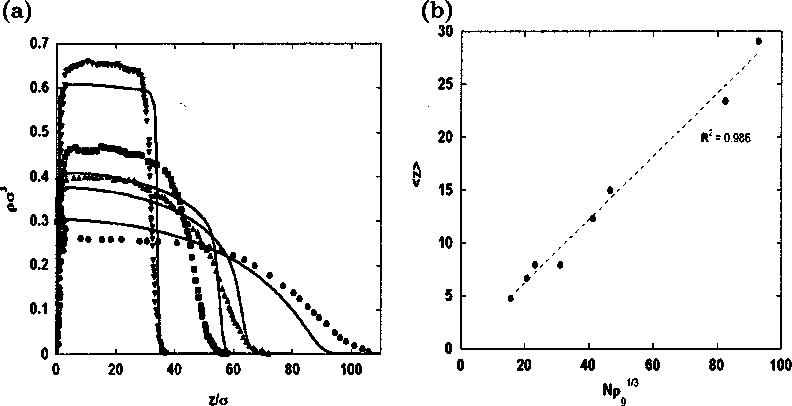Alexander [51] and de Gennes [52], where < z > can be defined as
z >=
ʃ zp{z)dz
fρ(z)dz ’
(6.29)
< z > is calculated for a number of polymer brushes at various Ng and pg. Figure 6.2b
shows that modified iSAFT follows the scaling relation for < z >. The maximum
distance to which the brushes extend away from the wall is defined as the brush height
h. Figure 6.2b also shows that h follows the same scaling relation. Numerically, h is
calculated as the normal distance from the wall after which the total segment density
of the tethered chains, pσ3 < 10~6.

Figure 6.3: (a) Segment density profiles of attractive chains tethered to a hard wall for
Ng = 200 and pgσ2 = 0.1 at e∕kT = 0 (∙), T* = 4 (à), T* = 3 (■) and T* = 2 (▼). Symbols
are the simulation results from Grest and Murat [230] and curves are the predictions from
modified iSAFT. (b) Average brush height, < z > vs Ngρ1f∕3 for attractive chains tethered
to a hard wall at T* = 4 (good solvent), for Ng = 50, 100 and 200 at different grafting
densities. Symbols are the prediction from modified iSAFT and the dashed curve is linear
fit to this data.
159
More intriguing information
1. Ultrametric Distance in Syntax2. Placentophagia in Nonpregnant Nulliparous Mice: A Genetic Investigation1
3. Locke's theory of perception
4. Iconic memory or icon?
5. Stable Distributions
6. A novel selective 11b-hydroxysteroid dehydrogenase type 1 inhibitor prevents human adipogenesis
7. Neural Network Modelling of Constrained Spatial Interaction Flows
8. Portuguese Women in Science and Technology (S&T): Some Gender Features Behind MSc. and PhD. Achievement
9. Delayed Manifestation of T ransurethral Syndrome as a Complication of T ransurethral Prostatic Resection
10. Parent child interaction in Nigerian families: conversation analysis, context and culture